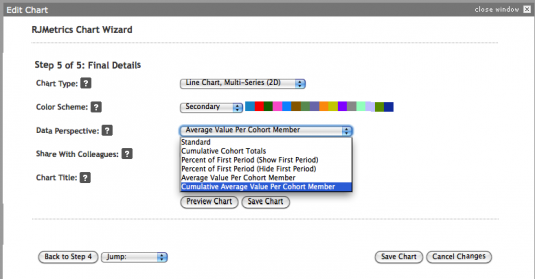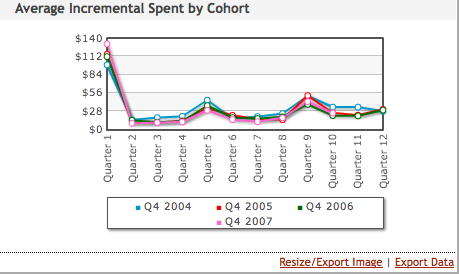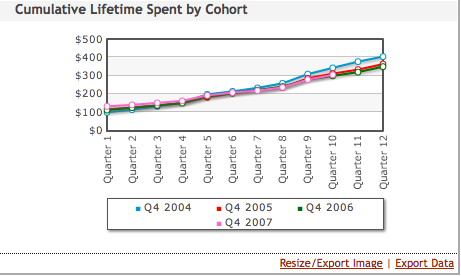Cohort analysis is a useful data analysis technique to help view loyalty trends, predict future revenue and monitor churn. RJMetrics users have found this technique to be very effective in quantifying the value of a company’s current customer base. When we initially rolled out the cohort analysis feature, we offered the following special data perspectives in step 5 of the RJMetrics chart wizard:
- Cumulative Cohort Totals
- Percent of First Period (Show First Period)
- Percent of First Period (Hide First Period)
We are pleased to announce two new valuable data perspectives:
- Average Value Per Cohort Member
- Cumulative Average Value Per Cohort Member
When creating a cohort chart using the RJMetrics chart wizard, you will find the two new data perspectives at the bottom of the ‘data perspective’ drop down menu. For this example we are viewing data belonging to our favorite fictitious company, Vandelay Industries.
Average Value Per Cohort Member
User-defined cohorts are now viewable by the average contribution per cohort member. This gives the user the ability to normalize against the size of the cohort.
In the graph below, we can now see the average first month’s spend for a number of Vandelay’s quarterly cohorts, along with their spend in subsequent months.
In many cases, this can be used to track how newer cohorts are behaving relative to their older counterparts.
Cumulative Average Value Per Cohort Member
This is the cumulative version of the perspective described above. If the user wishes to track their customers’ average lifetime spend across several cohorts over time, this perspective can deliver that view in just a click.
The chart below shows that Vandelay’s repeat purchase rate holds steady over time, translating to extremely high loyalty per average member, despite the amount of time since their first purchase.
These types of analysis can be used to help determine acceptable customer acquisition costs and predict the long-term purchasing behavior of new customers.
Additionally, you can restrict cohorts by customer attributes such as referral source or geography to provide more detailed views of how specific sub-groups behave over time.
Check out this earlier post to learn more about cohort analysis in RJMetrics.
If you’re interested in learning more about RJMetrics, check out our website where you can learn more and try out a free demo.



